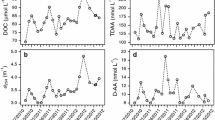Abstract
The molecular signature of dissolved organic matter (DOM) in groundwaters can be used as a tool when investigating the palaeohydrological response of groundwater systems in relation to changes in recharge environment, and also for examining groundwater compartmentalisation, mixing and transport at underground repositories for radioactive waste. The DOM in groundwaters from two compartmentalised bodies of groundwater of distinctly different origin within the Äspö Underground Research Laboratory (URL), Sweden and in Baltic seawater has been isolated using tangential flow ultrafiltration (TUF) and diafiltration. Recoveries of DOM ranged from 34.7 to 0.1 mg/L with substantial differences in the concentrations of the groundwaters collected only 120 m apart. Analysis by infrared spectroscopy (IR) and pyrolysisgas chromatography-mass spectrometry (Py-GC-MS) of the isolated DOM revealed that the groundwaters contained abundant alkylphenols which may represent heavily decomposed proteins or lignins originating from biopolymers contained within soils. The difference in the distribution and relative abundance of major pyrolysis products groups such as alkyphenols confirmed that the groundwater and Baltic seawater DOM samples were chemically distinct indicating minimal infiltration of marine groundwater derived by recharge from the Baltic or earlier Littorina Sea within the two compartmentalised groundwater bodies.
Similar content being viewed by others
References
A. Bath, A. Milodowski, P. Ruotsalainen, E-T. Tullborg, A. Cortés Ruiz and J.F. Aranyossy, EUR 19613 (2000), European Commission Luxembourg.
P. Degnan, A. Bath, A. Cortés, J. Delgado, R.S. Haszeldine, A. Milodowski, I. Puigdomenech, F. Recreo, J. Šilar, T. Torres and E-L. Tullborg . PADAMOT: Project Overview Report. United Kingdom Nirex Limited (2005).
R. Metcalfe, P.J. Hooker, W.G. Darling and A.E. Milodowski, in dating and duration of fluid flow and fluid-rock interaction. Geological Society of London Special Publication, 144, 233–260.
A.E. Milodowski, E-L. Tullborg, B. Buil, P. Gómez, M-J. Turrero, S. Haszeldine, G England, M.R. Gillespie, T. Torres, J.E. Ortiz, J. Zachariáš, J. Silar, M. Chvátal, L. Strnad, O. Šebek, J.E. Bouch, S.R. Chenery, C. Chenery, T.J. Shepherd and J.A. McKervey, J.A. PADAMOT Project Technical Report WP2. United Kingdom Nirex Limited (2005).
P.A. Meyers, Org. Geochem, 27, 213–250 (1997).
R. Benner and S. Opsahl, Org. Geochem. 32, 597–611 (2001).
R. Benner, B. Biddanda, B. Black and McCarthy M, Mar. Chem, 57, 243–263 (1997).
M. Goni, M. Teixeira and D.W. Perkey, D. W. Est. Coast. Shelf Sci. 57, 1023–1048 (2003).
X.Q. Lu, N. Maie, J.V. Hanna, D.L. Childers and R. Jaffe, R. Water Res. 37, 2599–2606 (2003).
S.W. Frazier, K.O. Nowack, K.M. Goins, F.S. Cannon, L.A. Kaplan and P.G. Hatcher, J. Anal. Appl. Pyrolysis, 70, 99–128 (2003).
S. Opsahl and R. Benner, Nature, 386, 480–482 (1987).
C.H. Vane Int. Biodet. Biodeg, 51, 67–75 (2003).
J.D.H. van Heemst, P.F. van Bergen, B.A. Stankiewicz and J.W. de Leeuw, J. Anal. Appl. Pyrolysis, 52, 239–256 (1999).
J. Templier, S. Derenne, J-P. Croue and C. Largeau, Org. Geochem. 36, 1418–1442 (2005).
J.D.H. van Heemst, L. Megens, P.G. Hatcher and J.W. de Leeuw, Org. Geochem, 31, 847–857 (2000).
D.H. Williams and I. Fleming, Spectroscopic methods in organic chemistry, edited by P. Sykes (McGraw-Hill, Maidenhead, 1966), p. 55.
C.H. Vane, C. H. Appl. Spectroscopy, 57, 514–517 (2003).
Y. Inbar, Y. Chen and Y Hadar, Soil Sci. Soc. of Amer. J. 54, 1316–1323 (1990).
S. Tsuge and H. Matsubara, J. Anal. Appl. Pyrolysis, 8, 49–64 (1985).
J. Ralph and R. Hatfield, J. Agric.Food Chem. 39, 1426–1437 (1991).
Author information
Authors and Affiliations
Rights and permissions
About this article
Cite this article
Christopher, H.V., Alexander, W.K., Antoni, E.M. et al. Molecular Characterisation of Dissolved Organic Matter (DOM) in Groundwaters from the Äspö Underground Research Laboratory, Sweden: A Novel “Finger Printing Tool for Palaeohydrological Assessment. MRS Online Proceedings Library 1107, 557 (2008). https://doi.org/10.1557/PROC-1107-557
Published:
DOI: https://doi.org/10.1557/PROC-1107-557




